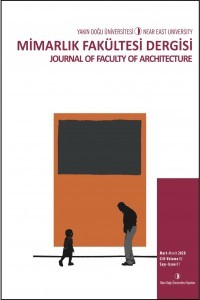Sürdürülebilirlikle İlişkili Bir Yerel Mimari Çalışması; Kuzey Nijerya Örneği
Sürdürülebilirlik kavramı yıllar geçtikçe çevreyi ve ekonomiyi daha fazla çöküşten korumak için mimarların, tasarımcıların, planlamacıların ve paydaşların ilgi gösterdiği önemli bir konu haline geldi. Çevrenin korunmasında, halk için barınma ve barınma sağlarken sürdürülebilir düşüncelerin uygulamaya konulmasını sağlamak için özen gösterilmelidir. Günümüzde pek çok insan yerel mimariyi arkaik olarak görüyor ve yerel mimarinin sürdürülebilirlikle ilgili önemli tepkisini ihmal ediyor. Yerel mimarinin yeri, çevre dostu, uygun maliyetli ve minimal modern teknolojiyi kullanan, ancak kullanıcılarının iyiliği için gerekli termal konforu sağlayan bu temel sürdürülebilir hususlardan bazılarını sağlıyor gibi görünmektedir. Bu araştırma çalışmasında, Kuzey Nijerya'daki yerel mimari, nitel araştırma yaklaşımı, ilgili literatür araştırması dahil edilerek analiz edildi ve sürdürülebilir önlemlerin vurgulanmasıyla sonuçlandı ve bu önlemlerin modern konut ortamına dahil edilebilmesi için çeşitli yollar önerildi. Halkın kültürünün, ekonomisinin ve ikliminin sürdürülebilirliği. Çevre, din ve kültür, Kuzey Nijerya'nın yerel mimarisine önemli katkılar olarak belirlendi.
Anahtar Kelimeler:
Yerel mimari, sürdürülebilirlik, barınak, çevre, kuzey Nijerya
A Study of Vernacular Architecture In Relation To Sustainability; the Case of Northern Nigeria
The concept of sustainability has over the years become one key subject that architects, designers, planners and stakeholders have taken interest in order to preserve the environment and economy from further decadence. In preserving the environment, care must be taken to ensure that sustainable considerations are put in place while providing housing and shelter for the populace. Many people today see vernacular architecture as archaic and neglect the significant response of vernacular architecture with regards to sustainability. The place of vernacular architecture seems to provide some of these basic sustainable considerations that are eco-friendly, cost effective and employs the use minimal modern technology yet providing the necessary thermal comfort for the wellbeing of its users. In this research work, vernacular architecture in Northern Nigeria was analyzed by engaging qualitative research approach, the study of relevant literatures and resulted in highlighting the sustainable measures put into use and suggest ways these measures can be incorporated in modern day housing environment so as to encourage the sustainability of the culture, economy and climate of the people. The environment, religion and culture were identified as key contributors to the vernacular architecture of Northern Nigeria.
Keywords:
Vernacular architecture, sustainability, shelter, environment, northern Nigeria.,
___
- Auwalu, F. K. (2019). Exploring the different vernacular architecture in Nigeria. Int. J. Afr. Soc. Cult. Tradit, 7, 1-12.
- Adamu, M. S. T. (2005). Interpretation of significant and messages in Hausa traditional architecture. Case of the “Zaure” entrance hall. Journal of the Association of Architectural
- Educators in Nigeria. Vol,4. Agboola, O. P., & Zango, M. S. (2014). Development of traditional architecture in Nigeria: a case study of Hausa house form. International Journal of African Society Cultures and Traditions, 1(1), 61-74.
- Chukwu, J. C. (2015). Traditional Igbo Building Architecture: An Historical Perspective.
- Journal of Art and Design Studies. 34 (7-14). Danja, I. I., Dalibi, S. G., & Safarov, A. (2017). Factors Shaping Vernacular Architecture of
- Northern Nigeria. Journal of Buildings and Sustainability, (1). Dmochowski, Z. R. (1990). An Introduction to Nigerian Architecture-Northern Nigeria.
- Ethnographica Ltd., London. pp, 1(1.10), 1-2. Ejiga, Opaluwa, Obi Paul, and O. Cordelia. "Sustainability in traditional African architecture: a springboard for sustainable urban cities."June Sustainable futures: architecture and urbanism in global south Kampala, Uganda (2012): 27-30.
- Fernandes, J. E. P., Mateus, R., & Bragança, L. (2014). The potential of vernacular materials to the sustainable building design.
- Hamza, B. The Concept Of Typology Classification:Taxonomy Of Architectural Types, Prototypes And Typologies. And The Hausa Traditional House Idowu, E. B. (1996). Olodumare (God in Yoruba Belief). Nigeria: Longman.
- Ikebude, C. M. (2009). Identity in Igbo Architecture: Ekwuru, Obi, and the African Continental
- Bank Building (Doctoral dissertation, Ohio University). Lawrence, R. J. (2006). Learning from the Vernacular. Vernacular Architecture in the 21st
- Century. Oxon: Taylor and Francis, 110-127. Lodson, J., Ogbeba, J. E., & Elinwa, U. K. (2018). A Lesson from vernacular architecture in
- Nigeria. Journal of Contemporary Urban Affairs, 2(1), 84-95. Massoudi, A., & Simonian, W. (1978). The Problem of Housing in Developing Countries.
- Housing Problems in Developing Countries, 175. Mustapha, B. (2020). Hausa Traditional architectural design 7.jpg - Wikimedia Commons. Retrieved https://commons.wikimedia.org/wiki/File:Hausa_Traditional_architectural_design_7.jpg , , from Wikimedia Commons website:
- National Bureau of Statistics. (2010). Annual Abstract of Statistics. Federal Republic of Nigeria.
- Nsude, G. C. (1987). The traditional architecture of the Igbo of Nigeria (Doctoral dissertation, Thames Polytechnic).
- Okoye, I. S. (2002). "Against History? A Nimo-Born Architecture of Umu Nri (Enugu Ukwu).
- Ijele: Art eJournal of the African World, (4). Olotuah, A. O. (1997, July). The house: accessibility and development-a critical evaluation of the Nigerian situation. In The House in Nigeria, Proceedings of the National Symposium, Bayo
- Amole (Ed.) Obafemi Awolowo University Ile–Ife, Nigeria (pp. 23-24). Udo, R.K., Kirk-Greene, A.H.M., Ajayi, J.F.A & Falola, T.O (2020). Nigeria. Encyclopedia. https://britannica.com/place/Nigeria.
- URL 1: https://thedotmanka.wordpress.com [retrieved 20, 12, 2020]
- URL 2: https://www.skyscrapercity.com [retrieved 20, 12 2020]
- URL 3: https://www.flickr.com [retrieved 20, 12 2020]
- URL 4: https://www. livingspaces.net [retrieved 20, 12 2020]
- ISSN: 2687-2757
- Başlangıç: 2019
- Yayıncı: Yakın Doğu Üniversitesi
Sayıdaki Diğer Makaleler
Yeşil Altyapı Kavramının Teorik Bir Çerçevede Değerlendirilmesi
İpek YARALIOĞLU, Buket ASİLSOY
Sürdürülebilirlikle İlişkili Bir Yerel Mimari Çalışması; Kuzey Nijerya Örneği
Ephraim Arome NOAH, Çiğdem ÇAĞNAN
Sanatta Demokratik İfade Biçimi - Özgünlük
Lefkoşa ve Mağusa’da Gotik Yapıların Mimari Elemanlara Göre Analizi
CBS ile Mimari Değerlendirme Analizi: Kaleici, Antalya Örneği
